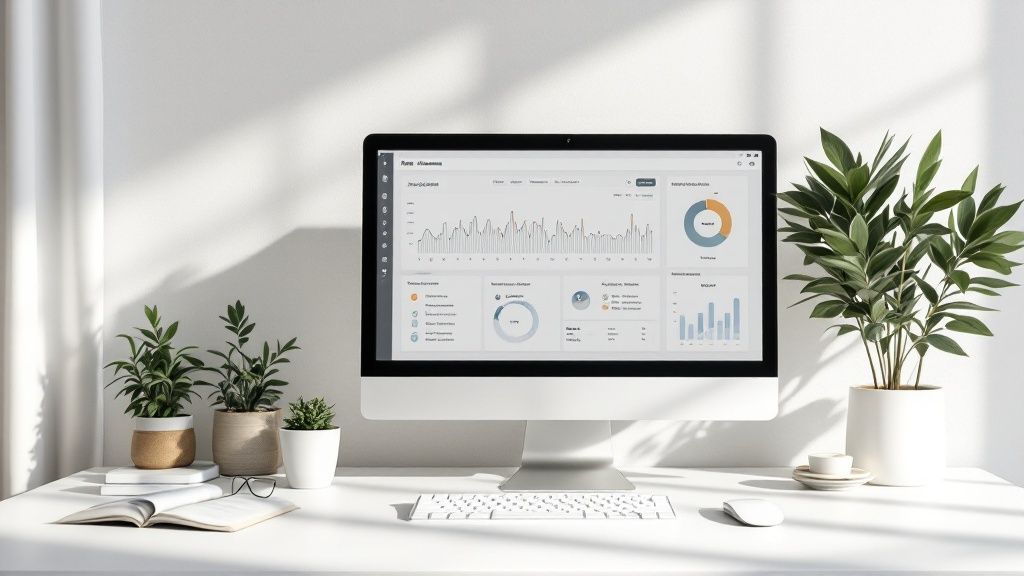The Email Automation Revolution: Why It Matters

Sending emails manually can be a real drain on your time. Think about all the effort that goes into crafting individual messages, personalizing greetings, and hitting send over and over again. That's where the power of email automation comes in. Automating your emails frees up your valuable time so you can focus on other important tasks.
Imagine a system that sends personalized emails to your subscribers or customers without you having to lift a finger. This isn't a futuristic dream; it's the reality of automated email marketing. This allows businesses and individuals to connect with their audience more efficiently and on a much larger scale.
Different Types of Automated Emails
Understanding the different types of automated emails is key to maximizing their impact. Transactional emails, such as order confirmations and shipping updates from platforms like Shopify, provide essential information to customers. These emails are triggered by specific actions and play a crucial role in the customer journey.
Marketing emails, on the other hand, nurture leads and promote products or services. They help build relationships with potential customers and keep your brand top-of-mind. This distinction allows for a more targeted approach, making sure the right message gets to the right person at the right time.
For example, a welcome email series can be automated to greet new subscribers and introduce them to your brand. Abandoned cart emails can remind customers about items left in their online shopping carts, gently nudging them to complete their purchase. These automated touches can significantly improve your conversion rates.
Measuring the Success of Automated Emails
Tracking statistics is essential for gauging the success of your automated email campaigns. A crucial metric is the open rate, which measures the percentage of recipients who open your email. For example, if you send a campaign to 8 users and 3 open the message, the open rate is 38% (3/8).
This metric helps marketers understand how engaging their subject lines and content are. Are they resonating with the target audience? By analyzing open rates, businesses can refine their subject lines, email content, and sending times to boost engagement and ultimately drive more conversions. For a deeper dive into email statistics, check out this resource: How Exactly Do We Calculate Email Sending Statistics?
Building Connections Through Automation
Effective email automation is all about building genuine connections with your audience. By prioritizing value and personalizing the experience, you can transform automated emails from simple notifications into powerful relationship-building tools.
This approach not only increases engagement but also fosters customer loyalty, setting the stage for long-term success. Nurturing leads and converting them into loyal customers is the ultimate goal, and automated emails can play a vital role in achieving this.
Selecting Your Perfect Email Automation Arsenal

Choosing the right email automation tools is critical for success. With so many options, finding the perfect fit for your needs and technical abilities is key. This means considering your budget, how easy the tool is to use, and the kinds of emails you'll be sending. Making informed decisions upfront will prevent headaches and keep your automation strategy running smoothly.
Key Considerations When Choosing an Email Platform
Several factors will influence your platform choice. User-friendliness is crucial, especially for those less tech-savvy. Some platforms offer simple drag-and-drop interfaces for creating visually appealing emails and automated sequences. This makes email marketing manageable, even without technical expertise.
Cost is another important factor. Pricing varies widely, from free plans with limited features to robust enterprise solutions. Evaluate your budget and choose a platform that offers the best value. For beginners, Mailchimp's free plan is a great starting point. For more advanced needs, platforms like ActiveCampaign offer more complex automation.
Integration with your existing marketing tools is also essential. Your chosen platform should connect seamlessly with your CRM, analytics tools, and other marketing software. This streamlines data flow and makes your campaigns more effective. A well-connected marketing ecosystem helps you use data insights to optimize your efforts.
Sending automated emails is vital for modern communication. Tracking key metrics, like bounce rate, is also important. Your bounce rate is the percentage of emails that aren't delivered due to problems like invalid addresses. Monitoring this helps you fix issues and improve deliverability. For more on bounce rate monitoring, check out Amazon SES Bounce Rate Monitoring.
Exploring Popular Email Automation Platforms
Several email automation platforms are worth highlighting. Mailchimp is popular for its user-friendly interface and comprehensive features, making it a good choice for beginners and small businesses. Its intuitive design and numerous templates make creating professional emails easy.
Constant Contact offers similar ease of use, along with solid email marketing features. It's a good option for small businesses looking for simple and affordable email communication.
ActiveCampaign is a more advanced platform suited for larger businesses with complex automation needs. Its sophisticated features, like behavioral automation and advanced segmentation, allow for highly targeted and personalized email campaigns.
For developers and businesses sending high volumes of email, Amazon SES offers a powerful and cost-effective solution. Its flexible API and scalability make it ideal for those who need customization and control.
To help you compare these platforms, here's a quick overview:
Email Automation Tool Comparison
| Tool | Best For | Key Features | Pricing Model | Technical Difficulty | |----------------|---------------------------------|----------------------------------------|-------------------|----------------------| | Mailchimp | Beginners, Small Businesses | User-friendly, Templates | Free/Paid | Low | | Constant Contact| Small Businesses | Ease of use, Email Marketing | Paid | Low | | ActiveCampaign | Larger Businesses, Complex Needs | Behavioral Automation, Segmentation | Paid | Medium | | Amazon SES | Developers, High Volume Sending | Flexible API, Scalability | Pay-as-you-go | High |
This table highlights the strengths of each platform, allowing you to choose the best fit based on your specific requirements. Consider your technical skills and the complexity of your email marketing strategy when making your decision.
Combining Tools for a Powerful Ecosystem
Many successful organizations combine different email automation tools. This allows them to use the best features of each platform to create a customized solution. For example, a company might use Amazon SES for transactional emails and Mailchimp for marketing campaigns. Integrating these tools with a CRM like Salesforce can further enhance automation and personalization.
Choosing the right email automation tools helps you communicate effectively, nurture leads, and drive business growth. By understanding your options and needs, you can build a powerful automation arsenal that maximizes your efforts.
Crafting Your First Automated Email Sequence That Converts

Now that you've selected your email automation platform, it's time to build your first automated email sequence. This is where your email strategy truly comes to life, transforming planning into tangible results. It’s more than just scheduling; it's about crafting a cohesive and engaging journey for your subscribers.
Segmenting Your Audience for Targeted Messaging
Before writing your emails, divide your audience into distinct groups. These segments can be based on shared interests, demographics, or past behavior. This targeted approach allows you to personalize messaging for maximum impact. For example, a welcome series could greet new subscribers, while loyal customers might receive product updates or exclusive offers. This personal touch makes your messages feel relevant and valuable.
Crafting Compelling Subject Lines
Subject lines are critical. They’re your first and often only opportunity to capture a reader's attention. A strong subject line can dramatically improve your open rates. Try various strategies, like asking questions, incorporating humor, or creating a sense of urgency. Above all, keep subject lines concise and clearly communicate the email's value.
Developing Engaging Email Content
A captivating subject line is just the beginning. Once you've piqued interest, deliver valuable and engaging content. Focus each email on a single topic, ensuring relevance to the recipient's interests. Use clear, concise language, and always include a strong call to action to guide readers towards the next step.
Establishing the Right Sending Cadence
Finding the optimal sending frequency is a delicate balance. Too many emails can overwhelm your audience and lead to unsubscribes. Too few, and you risk being forgotten. Start with a moderate cadence and adjust based on audience engagement and feedback. Experimentation is key, as there’s no universal solution. You might find this helpful: The Beginner’s Guide to Drip Email Campaigns.
Monitoring and Optimizing for Success
Sending automated emails is an ongoing process. Monitoring performance is essential for continuous improvement. Track key metrics like open rates, click-through rates, and conversions to understand what resonates with your audience. For example, monitoring delivery errors is crucial. Services like SendPulse offer detailed statistics on delivery errors, helping you identify and resolve issues like bounced emails. Find more detailed statistics here: SendPulse SMTP Statistics. A/B testing is another powerful tool. Experiment with different subject lines, content, and calls to action to optimize performance over time.
Beyond Basics: Advanced Email Automation Techniques

Sending automated emails is a good first step. But truly effective email marketing requires a more nuanced approach. It means creating a system that responds to your audience's actions, moving beyond basic automation to a truly personalized experience.
Behavioral Triggers and Dynamic Content
One advanced technique is using behavioral triggers. These triggers start automated emails based on what your subscribers do. For instance, if someone clicks a specific link, a follow-up email could automatically offer more details on that topic. This shows you're paying attention to their individual interests.
Dynamic content further personalizes the email's content based on user data. You could greet subscribers by name or recommend products based on past purchases. This added relevance makes your emails more valuable to each individual.
Intelligent Workflows and Conditional Logic
Intelligent workflows, driven by conditional logic, create sophisticated automation sequences. The subscriber's journey depends entirely on their interactions. For example, someone who opens a welcome email but doesn't click any links might receive a different follow-up compared to someone who does click a link.
These adaptive workflows deliver a far more personalized experience. This tailored approach is critical for optimizing email performance. Analyzing metrics like click-through and conversion rates helps refine strategies for better results. Automated email campaigns often rely on statistical analysis. You can explore this further here: Find more detailed statistics here
Leveraging User Interaction Data
Analyzing user interaction data is crucial for improving targeting and personalization. By tracking opens, clicks, and conversions, you gain valuable insights into preferences and behaviors. This data helps you segment your audience effectively and tailor your message for maximum impact.
These advanced techniques transform automated emails from static messages into dynamic conversations. By adapting to individual preferences and behaviors, you build stronger relationships with your subscribers, boosting engagement and driving better results. Moving from basic scheduling to intelligent automation is essential for long-term email marketing success.
Measuring What Matters: Optimizing Email Performance
Looking good isn't everything in email automation. High open rates are nice, but they don’t guarantee success. This section explores how to truly measure email performance, going beyond superficial metrics to focus on what truly drives results. We'll explore the indicators that reflect genuine engagement and how you can use data to continuously improve your automated email sequences.
Identifying Key Performance Indicators (KPIs)
Not all metrics are equally important. Open rates give you a peek into subject line effectiveness, but click-through rates (CTR) and conversion rates offer a much clearer picture of audience engagement and campaign success. CTR measures how many recipients clicked a link in your email, showing real interest in your content.
Conversion rate, on the other hand, tracks how many recipients completed a desired action, such as making a purchase or registering for a webinar. These metrics reveal how well your emails drive results. Also, tracking unsubscribe rates can tell you if your content or sending frequency is turning subscribers away.
Establishing Meaningful Benchmarks
Comparing your performance to industry averages can be useful, but fixating on generic benchmarks can be counterproductive. Instead, focus on creating meaningful benchmarks tailored to your specific industry, audience, and campaign objectives. This gives you a realistic view of your progress and helps pinpoint areas for improvement within your particular context.
For example, a welcome email series will likely have a different target CTR than a promotional email campaign. For more detailed guidance on establishing effective benchmarks, check out our guide on How to Measure Marketing Campaign Success.
To help you understand the key email automation metrics, we've compiled the following table:
Key Email Automation Metrics Essential metrics to track when evaluating automated email performance
| Metric | What It Measures | Ideal Range | How to Improve |
|---|---|---|---|
| Open Rate | How many recipients opened your email | Varies by industry, generally 15-25% | Compelling subject lines, sender recognition, optimal send times |
| Click-Through Rate (CTR) | How many recipients clicked a link in your email | Generally 2-5% | Clear call to action, engaging content, relevant links |
| Conversion Rate | How many recipients completed a desired action | Varies greatly depending on the goal, generally 1-5% | Targeted messaging, optimized landing pages, compelling offers |
| Unsubscribe Rate | How many recipients unsubscribed from your list | Less than 0.5% is generally considered good | Relevant content, appropriate sending frequency, easy unsubscribe process |
This table highlights the crucial metrics you need to monitor to ensure your email automation efforts are yielding positive results. By focusing on improving these metrics, you can create more effective email campaigns.
Implementing a Data-Driven Approach to Testing
Continuous improvement depends on data-driven decisions. A/B testing is a valuable tool for optimizing email performance. By experimenting with different subject lines, email content, calls to action, and send times, you can see what truly resonates with your audience. This iterative process lets you refine your automated sequences, ensuring they remain engaging and effective.
Testing two different subject lines, for example, can show you which one leads to a higher open rate. Testing different call-to-action buttons can help determine which wording or design drives more conversions.
From Static Sequences to Dynamic Systems
By prioritizing meaningful metrics and using a systematic testing approach, you can transform your automated email campaigns from static sequences into dynamic, evolving systems based on recipient behavior. This measurement-focused mindset is crucial for optimizing email performance and achieving your desired results. Continuously analyzing data and adapting your strategies ensures your emails stay relevant, engaging, and effective over the long term.
You might find this helpful: How to Master Marketing Campaign Measurement. This approach drives continuous improvement, helping you stay ahead and maximize the impact of your email automation.
Avoiding the Automation Traps That Sink Results
Automated email sequences are a powerful way to connect with your audience and boost conversions. But even the best-laid plans can go awry. Common pitfalls can derail your email effectiveness, turning a promising campaign into a wasted effort. Understanding these potential problems is key to long-term success.
The Perils of Poor Deliverability
One of the biggest hurdles in email marketing is getting your messages into your audience's inbox. Deliverability problems, often stemming from spam filters, can significantly impact your campaign’s reach. It's like sending a letter to the wrong address; the content doesn't matter if it never arrives. Maintaining a clean email list and following best practices for avoiding spam filters is crucial.
Preventing List Degradation
Email lists naturally degrade over time. Inactive subscribers, invalid email addresses, and spam traps accumulate, hurting your sender reputation and deliverability. Regular list cleaning is essential. Think of it like tending a garden: removing dead or unwanted plants allows the healthy ones to flourish. Proactive list management protects your sender reputation and ensures your messages reach active, engaged subscribers. For more tips, check out this helpful resource: Common Email Marketing Mistakes and How to Fix Them.
Combating Content Fatigue
Even engaged subscribers can experience content fatigue from a barrage of irrelevant or repetitive emails. Like listening to the same song repeatedly, even great content becomes tiresome if overused. This underscores the importance of varied and engaging content to keep your audience interested.
Best Practices to Avoid Automation Traps
Keep your automated email sequences running smoothly and effectively with these best practices:
- Regularly clean your email list: Remove inactive subscribers and invalid addresses. This keeps your list healthy, protects your sender reputation, minimizes bounce rates, and improves deliverability.
- Authenticate your emails: Use email authentication protocols like SPF, DKIM, and DMARC to verify your sender identity and boost deliverability. This helps prevent your emails from being flagged as spam.
- Segment your audience: Divide your subscribers into smaller groups based on interests or behavior. This allows for more relevant, targeted content, reducing content fatigue.
- Test and optimize your emails: A/B test different subject lines, content, and calls to action. This reveals what resonates best with your audience and helps you continuously improve your results.
- Monitor your metrics: Track key metrics like open rates, click-through rates, and unsubscribe rates. This helps identify potential problems and allows you to adjust your strategy accordingly.
By understanding and avoiding these automation traps, you can create sustainable email marketing campaigns that remain effective over time, nurturing your audience and achieving your goals.
Ready to personalize your email campaigns and boost engagement? OKZest helps you create unique, personalized images that capture attention and drive conversions. Learn more at OKZest.